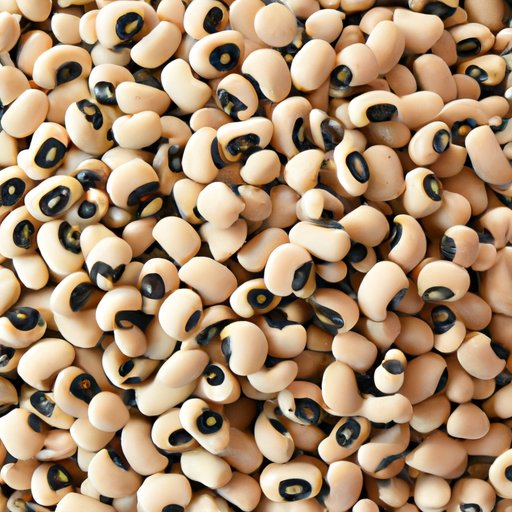Introduction
Black-eyed peas are a staple in many cultures and cuisines around the world. They are versatile, easy to cook, and pack a nutritional punch that makes them a popular choice for health-conscious eaters. In this article, we will provide a comprehensive guide to cooking black-eyed peas. Our recipe walkthrough will offer tips and variations for preparing flavorful black-eyed peas every time. We will also explore the health benefits of black-eyed peas and provide suggestions for incorporating them into your diet. You will also learn about regional variations and pairing suggestions to create a complete culinary experience with black-eyed peas.
Recipe Walkthrough
Proper seasoning and preparation are crucial to achieving delicious, flavorful black-eyed peas. Start by rinsing your dried peas and removing any debris or damaged peas. Soak the peas in water for at least 4 hours or overnight to soften them.
For basic seasoning, you’ll need a diced onion, minced garlic, and some salt and pepper. In a large pot, sauté the onion and garlic until fragrant. Add the peas and enough water to cover them by an inch. Bring to a boil, then reduce the heat and simmer for about 45 minutes to an hour, or until the peas are tender.
For variations on seasoning and preparation, you can add smoked meat or ham hocks for a smoky flavor. Or, you can spice things up with hot sauce, diced tomatoes with green chilies, and cumin for a Tex-Mex twist. For a creamy finish, add some heavy cream or coconut milk towards the end of cooking.
Tips for cooking perfect black-eyed peas:
- Avoid overcooking the peas, or they will become mushy and lose their texture
- Season to taste, adjusting salt and spices as necessary to achieve your desired flavor profile
- Increase the cooking time if your dried peas are particularly old or tough
Black-eyed peas are incredibly flexible and can be used in many different recipes. Here are a few suggestions:
- Black-eyed pea salad with cherry tomatoes, feta cheese, and a lemon vinaigrette
- Black-eyed pea hummus with pita chips
- Black-eyed pea and sausage soup with kale and potatoes
Health Benefits
Black-eyed peas are packed with nutrients and minerals that make them a great addition to any diet. They are an excellent source of protein, fiber, iron, and potassium. One cup of cooked black-eyed peas contains 13 grams of protein, 11 grams of fiber, and 20 percent of your daily recommended value of iron. They are also low in fat and calories, with only 160 calories per cup.
Suggestions on the ways you can incorporate black-eyed peas into your diet to receive their health benefits:
- Add them to soups and stews for an extra dose of protein and fiber
- Make a black-eyed pea and vegetable stir-fry
- Use black-eyed peas as a vegetarian protein source in salads or wraps
Comparison of Canned Versus Dried
There are advantages and disadvantages to using both canned and dried black-eyed peas. Canned peas are convenient and can save time, but they are often high in sodium and may contain preservatives. Dried peas take longer to prepare but can be healthier and less expensive in the long run.
If you opt for canned black-eyed peas, look for low-sodium options and rinse them well before use. For dried peas, follow the steps outlined in our recipe walkthrough, and be sure to soak the peas before cooking to ensure they cook evenly.
Regional Variations
Black-eyed peas have a rich history spanning across different cultures and regions. In the southern United States, black-eyed peas are traditionally served on New Year’s Day as a symbolic way to bring good luck and prosperity in the coming year. In Nigeria and the Caribbean, black-eyed peas are a staple ingredient in stews and rice dishes. In India and East Africa, black-eyed peas are used in curries and salads.
Here are some recipe suggestions and cooking techniques from different traditions:
- Black-eyed pea jambalaya with smoked sausage and shrimp
- Nigerian-style black-eyed pea stew with tomatoes, peppers, and spices
- Indian black-eyed pea curry with spinach and coconut milk
Pairing Suggestions
Black-eyed peas pair well with a variety of side dishes and beverages. Here are some suggestions:
- Cornbread or biscuits
- Coleslaw or a green salad
- Iced tea or a cold beer
The mild flavor of black-eyed peas makes them a great complement to bolder dishes like spicy chicken or barbecue ribs. Their high protein content also makes them a filling addition to vegetarian meals.
Conclusion
In conclusion, black-eyed peas are delicious, versatile, and packed with health benefits. Whether you are preparing them as a side dish or incorporating them into a main course, there is a recipe for everyone to enjoy. Our guide has provided information on how to cook black-eyed peas to perfection, its health benefits, regional variations, and pairing suggestions. It is time for you to try black-eyed peas with your choice of recipe and explore the many culinary possibilities.
